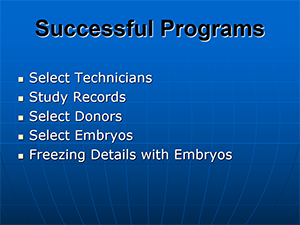
Increasing Reliability of Donor Response
Post Date: March 6, 2015

When considering where to apply management practices the three main areas should be apportioned as follows, 47% on reproduction, 24% on growth and 29% on carcass traits. As can be seen reproduction is by far the most important especially today with the high price of cattle so that even one more calf is significant. This relates to two more embryos achieved by improved management of donors plus some additional selection criteria which will be explained.
One new management tool is measuring anti-mullerian hormone (AMH) in donors. This hormone is related to oocyte (egg) reserves in cells found in the follicles. AMH is made in the granulosa cells in the follicles , so the larger number of follicles (all containing one oocyte) the higher is the concentration of AMH as measured in the blood of the donor. Samples can be taken at any time of the estrous cycle and should be refrigerated while waiting shipment to a laboratory. It is a good idea to speak to laboratory personnel initially to see how they want the sample handled and shipped, including the day of the week to avoid weekends and holidays.
Follicle management strategies also have to be improved. For instance restricting maintenance rations of cows during the first trimester of pregnancy to only 0.6 of recommended levels results in 60% fewer subsequent follicles in heifer calves born. Also dependent on nutrition is the health of the oocytes which are effected by carbohydrates in the ration. Oocytes are fed by cumulus cells which surround them within the follicle and the following train of events (all depend on the given nutrition), e.g. carbohydrates feed cumulus cells leading to more mitochondria (an energy source) in the plasma of the cells all contributing to the environment in the follicle and in the oviduct (the passage way to the uterus) and finally in the uterus itself where the embryo is fed by the uterine glands. Understanding these early cellular events (mostly ignored previously) and oocyte health leads to development or preventative measures to avoid detrimental practices that effect oocyte competence.
Additional recent studies are involved in identifying lethal recessives i.e. problems in the nucleus DNA leading to death of the embryo. For instance 33% of human embryos die due to these factors. By now you are probably thinking how does all of this effect my work in selecting and preparing donors? What can I do about these problems? At this time molecular biologists are discovering these factors in the gene contents of oocytes and embryos. These variants in the near future will be seen in the EPDs of potential donors so the astute breeder can avoid lethal carrier matings. It is estimated by the end of 2015 a list of these variants causing embryonic loss will be developed.
All of the above research is complex and you maybe thinking what can I do as a breeder ? Going back to the beginning of my report there are three management procedures to follow:
Click to View More Related Articles

When considering where to apply management practices the three main areas should be apportioned as follows, 47% on reproduction, 24% on growth and 29% on carcass traits. As can be seen reproduction is by far the most important especially today with the high price of cattle so that even one more calf is significant. This relates to two more embryos achieved by improved management of donors plus some additional selection criteria which will be explained.
One new management tool is measuring anti-mullerian hormone (AMH) in donors. This hormone is related to oocyte (egg) reserves in cells found in the follicles. AMH is made in the granulosa cells in the follicles , so the larger number of follicles (all containing one oocyte) the higher is the concentration of AMH as measured in the blood of the donor. Samples can be taken at any time of the estrous cycle and should be refrigerated while waiting shipment to a laboratory. It is a good idea to speak to laboratory personnel initially to see how they want the sample handled and shipped, including the day of the week to avoid weekends and holidays.
Follicle management strategies also have to be improved. For instance restricting maintenance rations of cows during the first trimester of pregnancy to only 0.6 of recommended levels results in 60% fewer subsequent follicles in heifer calves born. Also dependent on nutrition is the health of the oocytes which are effected by carbohydrates in the ration. Oocytes are fed by cumulus cells which surround them within the follicle and the following train of events (all depend on the given nutrition), e.g. carbohydrates feed cumulus cells leading to more mitochondria (an energy source) in the plasma of the cells all contributing to the environment in the follicle and in the oviduct (the passage way to the uterus) and finally in the uterus itself where the embryo is fed by the uterine glands. Understanding these early cellular events (mostly ignored previously) and oocyte health leads to development or preventative measures to avoid detrimental practices that effect oocyte competence.
Additional recent studies are involved in identifying lethal recessives i.e. problems in the nucleus DNA leading to death of the embryo. For instance 33% of human embryos die due to these factors. By now you are probably thinking how does all of this effect my work in selecting and preparing donors? What can I do about these problems? At this time molecular biologists are discovering these factors in the gene contents of oocytes and embryos. These variants in the near future will be seen in the EPDs of potential donors so the astute breeder can avoid lethal carrier matings. It is estimated by the end of 2015 a list of these variants causing embryonic loss will be developed.
All of the above research is complex and you maybe thinking what can I do as a breeder ? Going back to the beginning of my report there are three management procedures to follow:
- Pay attention to correct nutrition during the first trimester of pregnancy.
- Be aware of the coming new information in the EPDs.
- Check by blood sample the AMH level of the selected donor.
- Question: What are the optimal ages of donors for synchronization, superovulation and collection of embryos?
Answer: From 2.5 years to 8 years, but these data vary considerably. Obviously donors younger and older can be successful. - Question: When is a holstein cow too old to be flushed?
Answer: Age of successful donors is variable, but if the donor as she ages exibits regular estrous cycles chance of some success are good. Unfortunately quality of oocytes declines as the animal ages, which is demonstrated by the recovery of eggs, or poor quality embryos. - Question: How early can we start successful superovulation and flushing in Holstein's?
Answer: Increased reliable results are achieved when the heifer exibits regular estrous cycles. - Question: How does body condition of the recipient effect pregnancy rate?
Answer: Body conditions of 5 or 6 are optimum. When recipients are too thin the CL more frequently is lost by day 21. When they are too fat frequently the recipient does not ovulate so at Day 7 there is a lutein cyst. I have observed up to 50% of a group of fat recipients fail to ovulate. At the time of heat this type of recipient will show signs of estrus but they do not stand, so you have a good idea before the day of embryo transfer that there will not be a CL on the ovary.
Click to View More Related Articles
Testimonials
"The majority of our insight to embryo transfer is definitely accredited to Dr. Peter Elsden. The pragmatic experiences and personal attention offered through The International Embryo Technology School are highly commendable."… "An example of the benefits to our embryo transfer program, made possible by The International Embryo Technology School, is a cow that produces embryos for only $20 a piece. Each embryo is valued at $1,500 or more! We hold Dr. Peter Elsden and International Embryo Technology School with our highest regard, as they are largely responsible for our accomplishments."
Bob & Robin Stevenson
Stevenson Angus Ranch

|
|
|